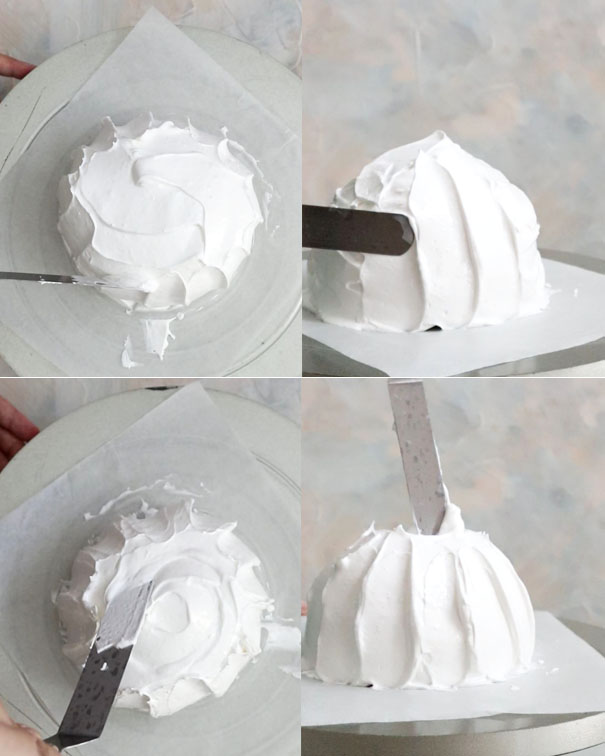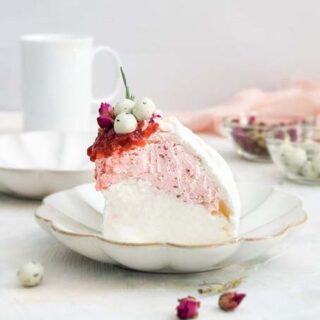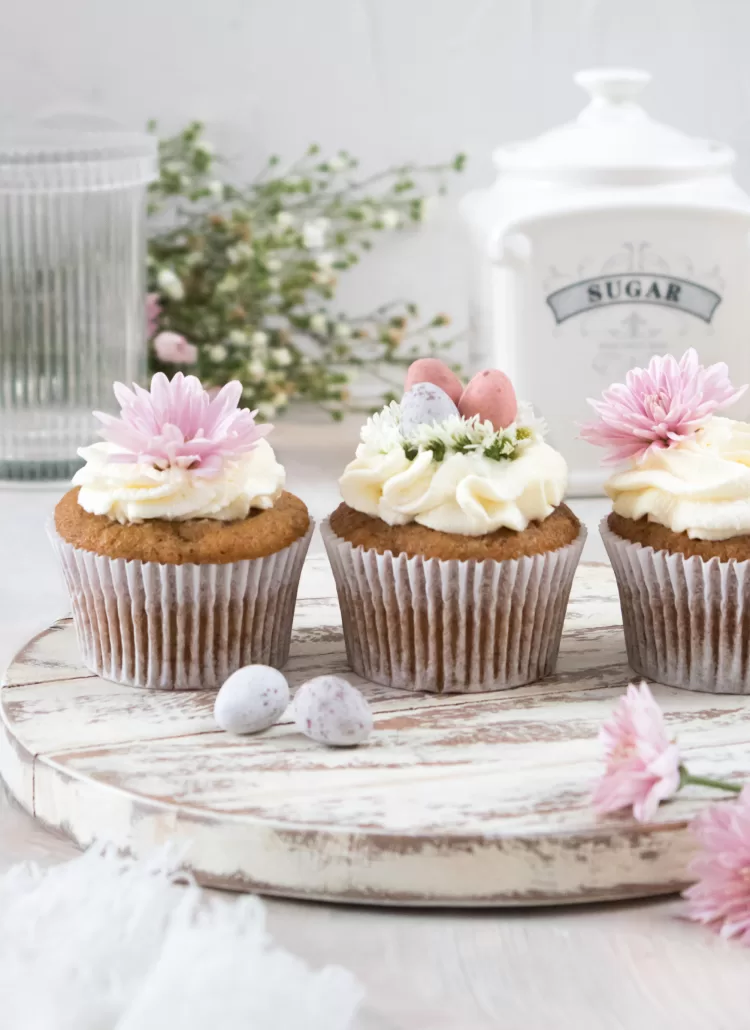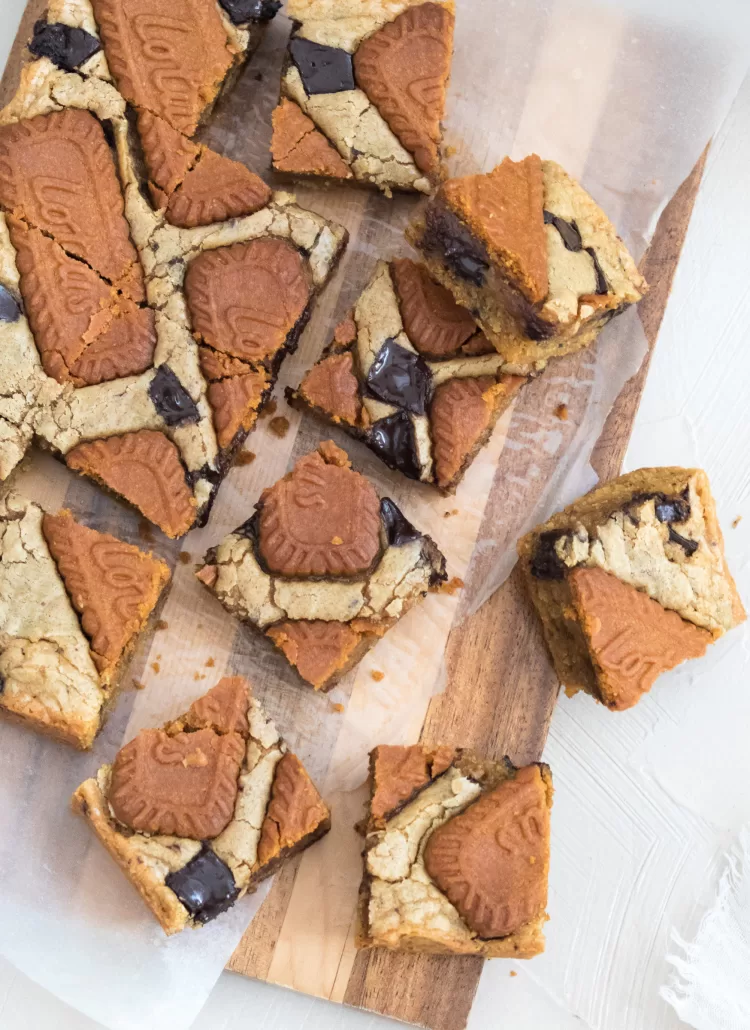Crispy pavlova shell, soft marshmallowy center, filled with raspberry rose cream, topped with raspberry compote and chocolate mini eggs. An elegant showstopper dessert that bursts with flavors and is perfect for Easter.
Easter is right around the corner! If you’re looking for an Easter dessert recipe that looks elegant and tastes oh-so-delicious to entertain your family or guests, this Raspberry Rose Pavlova is perfect for you!
Pavlova is so simple to make, but you need to make the shell a day before because it needs to cool down slowly in the oven. Then the next day, you can fill and decorate it right before serving. This beautiful raspberry rose pavlova is filled with fresh raspberry cream and homemade raspberry cream. Then, you can decorate it with rose buds, fresh raspberries, or mini eggs if you make this for Easter!

INGREDIENTS NEEDED TO MAKE THIS RASPBERRY ROSE PAVLOVA
- Egg whites – fresh eggs are best for making meringue and the egg whites need to come up to room temperature so that they whip better. Remove eggs from the refrigerator and separate them, then allow egg whites to reach room temperature.
- Fine sugar – you’ll use sugar for the meringue, and the cream. Sugar is so important for meringue. Besides adding sweetness, sugar helps stabilize the meringue’s structure by holding them together. Without sugar, the egg whites can break more easily. Speaking of sugar, make sure that you use fine caster sugar so the sugar can dissolve into the whipped egg whites easily.
- Vinegar – acid such as vinegar helps prevent the egg whites from collapsing and makes a more stable foam when the meringue is mixed.
- Salt – Pavlova is made with a lot of sugar, so salt is very important to balance the sweetness.
- Rose water – I got mine at a Turkish food store. You can also use rose extract.
- Raspberries – I use fresh raspberries, but frozen raspberries work too. If you prefer strawberry, strawberry + rose is also great.
- Lemon Juice – to enhance the flavors.
- Cornstarch – adding cornstarch helps the meringue to stay soft in the center. It also makes the center fluffier and marshmallowy
- Heavy whipping cream – for the creamy filling.
- Rose buds – for decoration
- Chocolate Mini Eggs – for decoration
EQUIPMENT YOU’LL NEED
- Parchment paper
- Medium baking sheet
- Stand mixer or hand-held mixer
- Rubber spatula
- Offset spatula

TIPS FOR THE BEST PAVLOVA
- Always make sure the bowl and whisk you are using to make your pavlova clean and dry.
- Egg whites need to come up to room temperature so that they whip better, and there must be no egg yolk in the mixture.
- Make sure to use superfine sugar, because sugar needs to be incorporated well to avoid sugar syrup weeping out of the pavlova when baking. Rub the mixture gently between your thumb and finger. It should have a smooth and glossy look.
- The mixture should be very thick (stiff peak), glossy, and soft. If they’re not stiff enough the pavlova will not hold its shape.
- After the baking process, turn the oven off and leave it in the oven for at least 2 hours (preferably overnight), to cool completely.
- Carefully peel the pavlova shell from the parchment and place it on the serving plate. It would help if you did this before you filled it.
STEP-BY-STEP INSTRUCTIONS TO MAKE THIS RASPBERRY ROSE PAVLOVA
(Be sure to check the recipe card below for the full ingredients list & instructions)
STEP 1 – Make the Pavlova Shell
Preheat your oven to 250F. Trace a 6-inch circle on a piece of parchment, then turn the parchment paper over so that the circle lines are underneath. Set it on a large baking sheet.
Using a stand mixer or a hand mixer fitted with a whisk attachment, whip the egg whites on medium speed until foamy, then add the vinegar and continue whipping until medium-stiff peaks about 3 minutes.
Drizzle in the sugar slowly while whipping the egg whites, about 2 tablespoons at a time. Once all the sugar is added, turn up the speed to medium-high and whip until stiff peaks. It should be very stiff, glossy, smooth, and have no sugar grains.
Stop the mixer and scrape down the sides and bottom of the bowl. With the mixer on medium-low speed, gradually add in salt, cornstarch, and ice-cold rose water. Mix for about 2 minutes and make sure it distributes evenly. The mixture should still be very stiff.
Scoop and dump the mixture onto your prepared baking sheet. Use the circle you drew as your guide, and spread out the meringue with a spatula to create a large meringue nest. Smooth the sides and clean up the bottom. Now you can shape the meringue by using a spatula to create the shell design and indent the top to help the center crack and sink in evenly.
Carefully place the pavlova in the oven. Bake at 250F for 20 minutes or until the meringue starts to turn a very pale tan color. Reduce the heat to 220F continue to bake for another 90 minutes. Turn the oven off and leave the pavlovas in there to cool slowly for at least 3 hours, preferably overnight.
STEP 2 – Make the Raspberry Compote
Using a medium-sized saucepan over medium heat, mix the raspberries with all the ingredients. Bring to a boil, and stir constantly. Reduce the heat and simmer for about 10 minutes until it thickens. Remove from heat and allow to cool completely.
STEP 3 – Make the Raspberry Rose Cream
Put the bowl of a standing mixer or a large mixing bowl into the refrigerator to chill for at least 30 minutes. Add the cold heavy whipping cream (straight from the refrigerator), powdered sugar, and vanilla extract to the chilled bowl and whisk on medium-high speed until it is almost stiff peaks, then fold in half of the cooled raspberry compote.
STEP 4 – Assemble and Serve
When you’re ready to serve the pavlova, carefully peel the pavlova shell from the parchment and place it on the serving plate. It would help if you did this before you filled it. If it cracks slightly, that’s totally ok. Use a pastry bag to carefully fill the pavlova with whipped cream, add the remaining raspberry compote on top, and decorate with rose buds, mini eggs, or fresh raspberries

PAVLOVA TROUBLESHOOTING
If the pavlova cracks slightly, that’s okay, but weeping and collapsing are the worst. This can happen while the pavlova is cooling, or even while it’s baking. These are the most common causes of pavlova fails, and why they happen.
- Sugar didn’t dissolve properly – The problem here is the sugar in the meringue mixture. The sugar wasn’t mixed in properly with the egg whites before the meringue went into the oven, so it melts out of the bottom of your pavlova. If a pavlova weeps too much, the texture will become soggy, and it will collapse. That’s why using fine caster sugar is important for pavlova, because caster sugar has more finely ground crystals, so it dissolves faster than regular sugar.
- High humidity – It’s almost impossible to bake a proper pavlova on high-humidity days. The sugar in the pavlova will absorb moisture from the air, so the egg whites in the structure will not be able to hold the sugar molecules that absorb moisture, resulting in a weeping and collapsed pavlova.
- The oven is too hot while baking – Pavlova is baked at a low temperature and very slowly. Too hot oven will make the meringue expand too fast, causing it to rise, spread, and crack. So make sure to bake pavlova in a low-temperature oven to make it stable, crisp, and dry on the outside, and marshmallowy center.
- Cooling too quickly – After baking, pavlova needs to be cooled down slowly. Don’t open the oven’s door, just leave the pavlova in there for at least 2 hours to cool completely. If the temperature changes too fast, this can make the marshmallowy center shrink rapidly, causing the pavlova to crack and collapse.
HOW TO STORE THIS RASPBERRY ROSE PAVLOVA
Pavlova shell (before filling it with cream and compote) can be stored for up to 24 hours. I’d recommend storing it inside the oven (a cool, turned off oven). In my experience, storing the pavlova shell in an airtight container makes it weep and go soft.
You need to refrigerate leftover pavlova as it has a whipped cream topping, but it tends to absorb moisture inside the fridge so the texture will go a little soggy.

Raspberry Rose Mini Egg Pavlova
A beautiful showstopper dessert that literally bursts with flavors and is perfect for your Easter party. Crispy pavlova shell, soft marshmallowy center, filled with raspberry rose cream, topped with raspberry compote and chocolate mini eggs.
Ingredients
Rose Water Pavlova
- 150g (about 5) large egg whites
- 250g (1 + 1/4 cups) caster sugar
- 1 teaspoon vinegar
- 1 tablespoon cold rose water
- a pinch of salt
- 1 tablespoon cornstarch
Raspberry Compote
- 340g (2 cups) fresh raspberries
- 1 tablespoon caster sugar
- 2 teaspoon lemon juice
- 1 teaspoon lemon zest
- 1 teaspoon rose water
- 1 teaspoon cornstarch
Raspberry Rose Cream
- 2 cups heavy cream
- 2 tablespoons powdered sugar
- 1 teaspoon vanilla extract
- Half of the raspberry compote
Instructions
STEP 1 – Make the Pavlova Shelll
Preheat your oven to 250F. Trace a 6-inch circle on a piece of parchment, then turn the parchment paper over so that the circle lines are underneath. Set it on a large baking sheet. Using a stand mixer or a hand mixer fitted with a whisk attachment, whip the egg whites on medium speed until foamy, then add the vinegar and continue whipping until medium-stiff peaks about 3 minutes.
Drizzle in the sugar slowly while whipping the egg whites, about 2 tablespoons at a time. Once all the sugar is added, turn up the speed to medium-high and whip until stiff peaks. It should be very stiff, glossy, smooth, and have no sugar grains. Stop the mixer and scrape down the sides and bottom of the bowl. With the mixer on medium-low speed, gradually add salt, cornstarch, and ice-cold rose water. Mix for about 2 minutes and make sure it distributes evenly. The mixture should still be very stiff.
Scoop and dump the mixture onto your prepared baking sheet. Use the circle you drew as your guide, and spread out the meringue with a spatula to create a large meringue nest. Smooth the sides and clean up the bottom. Now you can shape the meringue by using a spatula to create the shell design and indent the top to help the center crack and sink in evenly. Carefully place the pavlova in the oven. Bake at 250F for 20 minutes or until the meringue starts to turn a very pale tan color. Reduce the heat to 220F continue to bake for another 90 minutes. Turn the oven off and leave the pavlovas in there to cool slowly for at least 3 hours, preferably overnight.
STEP 2 – Make the Raspberry Compote
Using a medium-sized saucepan over medium heat, mix the raspberries with all the ingredients. Bring to a boil, and stir constantly. Reduce the heat and simmer for about 10 minutes until it thickens. Remove from heat and allow to cool completely.
STEP 3 – Make the Raspberry Rose Cream
Put the bowl of a standing mixer or a large mixing bowl into the refrigerator to chill for at least 30 minutes. Add the cold heavy whipping cream (straight from the refrigerator), powdered sugar, and vanilla extract to the chilled bowl and whisk on medium-high speed until it is almost stiff peaks, then fold in half of the cooled raspberry compote.
STEP 4 – Assemble and Serve
When you’re ready to serve the pavlova, carefully peel the pavlova shell from the parchment and place it on the serving plate. It would help if you did this before you filled it. If it cracks slightly, that’s totally ok. Use a pastry bag to carefully fill the pavlova with whipped cream, add the remaining raspberry compote on top, and decorate with rose buds, mini eggs, or fresh raspberries
♥ ♥ ♥
If you try this recipe, I’d love to hear what you think! Send me a message or write a comment below.
Also be sure to snap a picture and tag me on your social media posts with #thejobaker
Happy Baking!




Leave a Reply